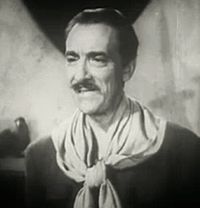Pedro de Cordoba
This article needs additional citations for verification. (July 2015) |
Pedro de Cordoba | |
|---|---|
 Pedro de Cordoba in The New Theatre, 1909 | |
| Born | September 28, 1881 New York City, USA |
| Died | September 16, 1950 (aged 68) Sunland, California, USA |
| Resting place | Holy Cross Cemetery, Culver City |
| Occupation | Actor |
| Years active | 1915–1951 |
| Spouse(s) | Eleanor M. Nolan (1928–?) Antoinette Glover (?–1921) (her death) |
Pedro de Cordoba (September 28, 1881 – September 16, 1950) was an American actor.
Biography
De Cordoba was born in New York City to parents who were French and Cuban in origin. He was a classically trained theatre actor who confessed he did not enjoy appearing in silent films nearly as much as he liked working on stage, but his career during the silent film era was extensive. His first film was Cecil B. DeMille's version of Carmen (1915), and he soon became a popular leading man in Hollywood. His Broadway career cast him with such stage actresses as Jane Cowl and Katharine Cornell.
Later, his deeply resonant speaking voice made him perfectly suited to talking pictures, and his film career continued, unlike many silent film stars. He enjoyed a career as a busy character actor in Hollywood, from the 1930s through to the end of his life. He was most often cast as aristocratic, or clerical characters of Hispanic origin, as in The Keys of the Kingdom (1944), because of his last name as well as his royal bearing. On rare occasions, he would be cast in the role of a villain. His "living skeleton" sideshow character hides fugitive Robert Cummings (and Priscilla Lane) in his carnival wagon overnight in the Alfred Hitchcock film Saboteur (1942).
He was a devout Catholic and was very well read and knowledgeable about the Catholic faith, and served for a time as president of the Catholic Actors Guild of America. The last film in which he appeared, a political drama set in an unnamed South American dictatorship, Crisis (1950), was released shortly after his death.
Selected filmography



Silent
- The Little White Violet (1915) (*short)
- Jeanne of the Woods (1915) (*short)
- Carmen (1915)
- Temptation (1915)
- Maria Rosa (1916)
- Just a Song at Twilight (1916)
- Sapho (1917)
- One Law for Both (1917)
- Barbary Sheep (1917)
- Runaway, Romany (1917)
- A Daughter of the Old South (1918)
- The New Moon (1918)
- The Dark Mirror (1919)
- The World and His Wife (1920)
- The Sin That Was His (1920)
- The Inner Chamber (1921)
- The Young Diana (1922)
- When Knighthood Was in Flower (1922)
- I Will Repay (1923)
- Enemies of Women (1923)
- Fires of Fate (1923)
- The Purple Highway (1923)
- The Bandolero (1924)
- The New Commandment (1925)
Sound
- Hunt the Tiger (1929) (*short)
- The Crusades (1935)
- Condemned to Live (1935)
- Captain Blood (1935)
- Professional Soldier (1935)
- Trouble for Two (1936)
- The Devil-Doll (1936)
- Anthony Adverse (1936)
- His Brother's Wife (1936)
- Ramona (1936)
- The Garden of Allah (1936)
- Maid of Salem (1937)
- The Firefly (1937)
- International Settlement (1938)
- Devil's Island (1939)
- Juarez (1939)
- Man of Conquest (1939)
- Charlie Chan in City in Darkness (1939)
- Escape to Paradise (1939)
- Law of the Pampas (1939)
- The Light That Failed (1939)
- My Favorite Wife (1940)
- The Ghost Breakers (1940)
- The Sea Hawk (1940)
- Before I Hang (1940)
- The Mark of Zorro (1940)
- Aloma of the South Seas (1941)
- The Corsican Brothers (1941)
- Saboteur (1942)
- The Falcon Takes Over (1942)
- Tarzan Triumphs (1943)
- White Savage (1943)
- Uncertain Glory (1944)
- The Falcon in Mexico (1944)
- Kismet (1944)
- Tahiti Nights (1944)
- San Antonio (1945)
- A Scandal in Paris (1946)
- Swamp Fire (1946)
- Carnival in Costa Rica (1947)
- Robin Hood of Monterey (1947)
- The Time of Your Life (1948)
- Omoo-Omoo, the Shark God (1949)
- Samson and Delilah (1949)
- Comanche Territory (1950)
- Cuban Fireball (1951)
Radio appearances
| Year | Program | Episode/source |
|---|---|---|
| 1937 | Lux Radio Theatre | Madame Butterfly |
| 1946 | Hollywood Star Time | The Song of Bernadette[1] |
References
- ^ "Those Were the Days". Nostalgia Digest. 41 (2): 32–41. Spring 2015.
External links
- American male stage actors
- American male silent film actors
- American male film actors
- Male actors from New York City
- American people of Cuban descent
- American people of French descent
- 1881 births
- 1950 deaths
- Burials at Holy Cross Cemetery, Culver City
- 20th-century American male actors
- American Roman Catholics
